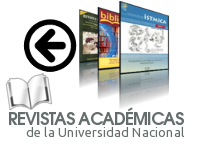Bordering the New Spain Between Aztlán (NM) and Cuzcatlán (SV)
DOI:
https://doi.org/10.15359/istmica.24.3Keywords:
Chronicle, Cultural History, Linguistcs, Migration, MythsAbstract
New Mexico and Central America are united by Pre-Hispanic and Colonial history. While Uto-Nicarao languages expand from Utah to Nicaragua, the Christ of Esquipulas’ pilgrims travel from El Trifinio (Central America Northern Triangle) to Chimayo (NM). “Bordering the New Spain. Between Aztlán (NM) and Cuscatlán (SV)” explores both sides of an ancient Viceroyalty to unveil a Camino Real (Real and Royal Road) whose forgotten signs are recognized only by subjective deposition. In the first place, a personal chronicle explains Hispanic admiration to their own legacy in the USA, which would connect them to the South. Afterwards, the essay comments ancestral linguistic and cultural bounds —forgotten by national history and civism— between the southwest of the USA and the northern triangle of Central America.
References
Referencias bibliográficas
- AULEX. Diccionario Náhuatl. Recuperado de: https://aulex.org/nah-es/.
- Bombal, M. L. (1941). El árbol. Recuperado de: https://ciudadseva.com/texto/ el-arbol-bombal/ http://biblioteca.org.ar/libros/323.pdf.
- Campbell, L. (1985). The Pipil Language of El Salvador. The Hague: Mouton.
- Carpenter, J. (2015). El camino del norte a Chimayó. An American Pilgrimage. Recuperado de: https://www.americanpilgrims.org/assets/documents/essays/carpenter_camino_norte_chimayo.pdf.
- Carpentier, A. (1944). Viaje a la semilla. Recuperado de: https://ciudadseva.com/ texto/viaje-a-la-semilla/
- Derrida, J. (1995). Mal de archivo (1994). Paris: Galilée. Recuperado de: https://filologiaunlp.files.wordpress.com/2012/01/maldearchivo.pdf/ https:// redaprenderycambiar.com.ar/derrida/.
- Derrida, J. (2002). Trace et archive, image et art. Recuperado de: https:// redaprenderycambiar.com.ar/derrida/frances/trace_archive.htm.
- Geoffroy Rivas, P. (2001). Obra completa. San Salvador: Dirección General de Publicaciones e Impresos (DPI). Rafael Lara-Martínez (Ed.). Gran Diccionario Náhuatl. Recuperado de: http://www.gdn.unam.mx/termino/ search.
- Heidegger, M. (1971). Poetry, Language, Thought. New York: Harper & Row.
- Heidegger, M. (1982). On the Way to Language. New York: Harper & Row.
- Isler Soto, C. (2008). El tiempo en “Las confesiones” de San Agustín. Revista de Humanidades de la Universidad Andrés Bello, Chile, junio-diciembre: 187-199.
- Kavafis, K. (1911). Viaje a Ítaca. Recuperado de: http://www.pixelteca.com/ rapsodas/kavafis/itaca.html/ http://www.lluisllach.cat/catala/itaca.htm / http://www.lluisllach.cat/catala/itaca.htm/ https://www.youtube.com/ watch?v=NtkAV0UPCVA.
- Lafaye, J. (1977). Quetzalcóatl y Guadalupe. México: FCE.
- Lara-Martínez, R. (2017). 7/Chicôme estudios náhuat-pipiles. San Salvador: Universidad Don Bosco-Universidad Evangélica-Alcaldía de San Salvador. Matta. Recuperado de: http://www.artnet.com/artists/roberto-matta/.
- Molina, F. (2016). Vocabulario de la lengua castellana y mexicana. Recuperado de: http://www.vcn.bc.ca/prisons/Molina_Vocabulario_Puebla-1910.pdf. Marc Thovenor (Ed.), Miguel León-Portilla (Prólogo) y Javier Manrique Amao (Colaboración), México; UNAM. Recuperado de: http://www.historicas.unam.mx/publicaciones/catalogo/ficha?id=625.
- Navarrete Cáceres, C. (Ed.). (2013). En la diáspora de una devoción. Acercamientos al estudio del Cristo de Esquipulas. México: UNAM-IIA. Recuperado de: https://www.researchgate.net/profile/Marx_Navarro-Castillo/publication/293815144_Culto_Popular_del_Senor_de_Esquipulas_en_Tapachula_Chiapas/links/56bb94cd08ae47fa3956aa7d/Culto-Popular-del-Senor-de-Esquipulas-en-Tapachula-Chiapas.pdf.
- Onetti, J. C. (1973). La novia robada. México: Siglo XXI Editores.
- Ricoeur, P. (2008). Temps et récit. 3 volumes. Paris: Ed du Seuil.
- Rémy, S. (1977). Diccionario de la lengua náhuatl o mexicana. México, D. F.: Ed. Siglo XXI.
- Sahagún, F. B. (1978). Visión de los vencidos. México: UNAM. Miguel León-Portilla (Ed.).
- Sábato, E. (1985). El túnel. Madrid: Editorial Cátedra. Salarrué. Obras escogidas. San Salvador: Editorial Universitaria, 1969-1970. Hugo Lindo (Ed.).
- San Agustín. (s.f.). Las confesiones. Recuperado de: http://www.diocesisdecanarias.es/pdf/confesionessanagustin.pdf/ http://www.biblioteca.org.ar/libros/132410.pdf/ http://faculty.georgetown.edu/jod/latinconf/latinconf.html.
- Steve Miller Band. “Fly like an Eagle”. Recuperado de: https://genius.com/ Steve-miller-band-fly-like-an-eagle-lyrics
- Wilder, T. (2013). Heaven’s my Destination (1935). New York: Harper Perennial.
Downloads
Published
How to Cite
Issue
Section
License
Las personas autoras que publiquen en esta revista permiten cesión gratuita, exclusiva, de ámbito mundial de sus derechos de autoría a la Universidad Nacional (Costa Rica), conservando únicamente sus derechos morales sobre la obra publicada.
Los artículos pueden ser citados y copiados, citando a la persona autora y la fuente. Todos los artículos publicados en la Revista Ístmica están protegidos bajo una Licencia Creative Commons Atribución-NoComercial-CompartirIgual 4.0 Internacional







